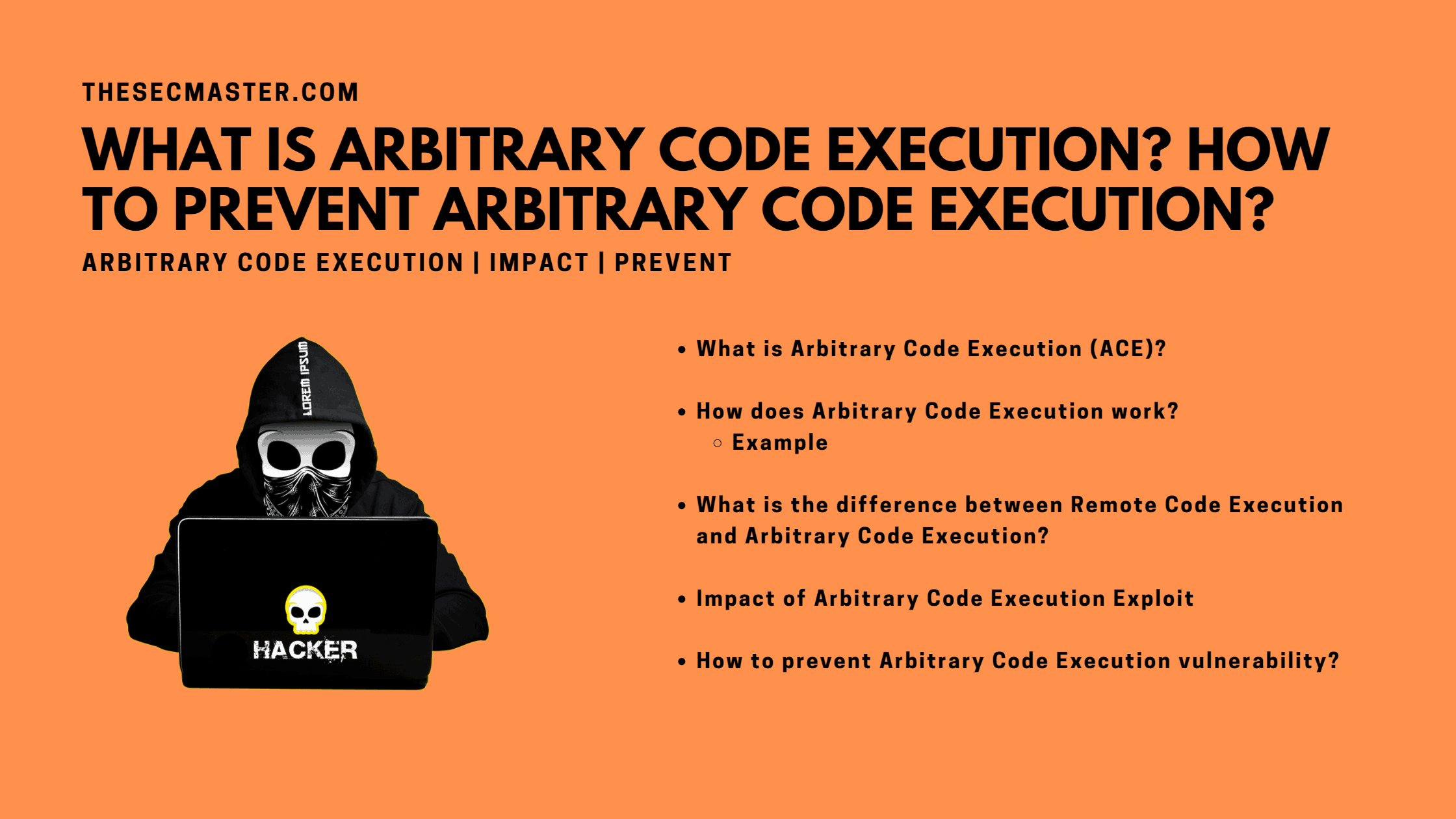Table of Contents
What Is Arbitrary Code Execution? How To Prevent Arbitrary Code Execution?
In this digital age, many organizations have developed web-based applications that allow easy access and uninterrupted services to users. If the applications are written without security standards. Those can be manipulated to get unauthorized access to the webserver and user data. Arbitrary code execution is a security flaw allowing criminals to execute arbitrary commands on the target system.
In this article, we will learn what arbitrary code execution vulnerability is, how it works, and what you should do to prevent this vulnerability. Also, we will make a comparison of arbitrary and remote code executions. So, let’s get started.
What Is Arbitrary Code Execution (ACE)?
Arbitrary code execution or ACE is an attacker’s ability to execute any code or commands of the attacker’s choice on a target machine without the owner’s knowledge. An ACE vulnerability is a security flaw in software or hardware that allows arbitrary code execution. A program designed to exploit such a vulnerability is known as arbitrary code execution exploit. The potential to trigger ACE over a network is often referred to as remote code execution (RCE).
Arbitrary code opens a backdoor into a system or steals sensitive user information (such as passwords), or turns off security protection to launch attacks. The arbitrary code execution vulnerability means that an attacker could upload malicious code to a system by exploiting a vulnerability and trick the remote system into executing that code. The technique used to upload malicious code to a system is called injection.
How Does Arbitrary Code Execution Work?
Computers can not differentiate between commands and valid inputs. If you use a proper sequence of letters and numbers and the system is built to accept them, you can transform any entry into an attack. An attacker can trigger an already existing problem, modify information within a program, install a program to run later, or load different code.
The target device or software controls the access level an attacker has, but the attacker’s goal is to escalate the privileges. Basically, the attacker tries to gain administrative control over the device. If they succeed, the system could become a zombie device for attackers to exploit in another attack.
Example
In 2014, a gamer used buttons on a controller and Arbitrary Code Execution to hijack the video game Super Mario World. Retrogaming hobbyists managed to detect vulnerabilities in the classic video game to execute malicious code. They can have considerable consequences than altering a video game. Attackers can use Arbitrary Code Execution to run extortion schemes and steal data. Search history and private text messages can also be exposed when attackers use ACE.
What Is The Difference Between Remote Code Execution And Arbitrary Code Execution?
Arbitrary code execution allows a hacker to exploit vulnerabilities to run a code or command on a target system. However, Remote code execution allows a hacker to exploit vulnerabilities to trigger arbitrary code execution on a target system or device remotely from another system, usually from a WAN.
Impact Of Arbitrary Code Execution Exploit
Arbitrary code execution exploits can be disastrous for your website, application, or system. It can harm you in the following ways.
Once hackers gain access to your website, they run arbitrary code to navigate and assess your files and find ways to gain full access to your website or application.
Hackers can modify or delete files or steal sensitive data and sell it on the black market, compromising users’ confidentiality and integrity.
They can launch hack attacks or send spam emails on other websites using your site’s resources.
How To Prevent Arbitrary Code Execution Vulnerability?
You must think of all the prevention techniques using which someone might tap into and exploit a system.
If you notice any unusual and unfamiliar users, instantly remove them. It is recommended to have only one admin and set other roles to the least privileges required. Delete all unknown FTP accounts.
Schedule regular malware and vulnerability scans. It will allow you to mitigate potential security flaws at an early stage.
Know that any software you use is vulnerable. Make sure to patch your systems and software regularly and devotedly. Do not let known exploits ruin your safety.
Keep your anti-malware tools up to date as well. Because if you didn’t patch the vulnerability software yet, anti-malware may detect and block ACE exploits.
Blacklist the IPs obtained from previous attacks. It will help prevent any future attack from the same malicious source and tackle an attack before it begins.
Use strong usernames and passwords. If you use credentials that are easy to guess, anyone can gain access to your website. Unique and strong credentials help you secure your website.
You may also like these articles:
What Is Remote Code Execution? How To Prevent Remote Code Execution?
How To Fix CVE-2022-24086- A Critical 0-Day Arbitrary Code Execution Vulnerability In Magento
What Is Command Injection Vulnerability? And How To Prevent It?
How To Fix CVE-2021-44228 Log4Shell- A Critical 0-DAY RCE In Log4j Logging Library?
Arun KL
Arun KL is a cybersecurity professional with 15+ years of experience in IT infrastructure, cloud security, vulnerability management, Penetration Testing, security operations, and incident response. He is adept at designing and implementing robust security solutions to safeguard systems and data. Arun holds multiple industry certifications including CCNA, CCNA Security, RHCE, CEH, and AWS Security.
